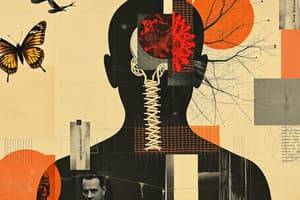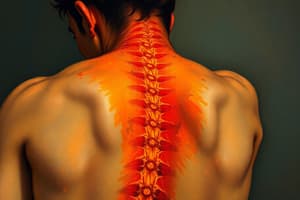Podcast
Questions and Answers
What receptors do Aδ-fibres express that are related to thermosensation?
What receptors do Aδ-fibres express that are related to thermosensation?
- Nav1.7 and Nav1.9
- TRPV2 and TRPM5
- TRPA1 and Nav1.8
- TRPM8 and TRPV1 (correct)
Which of the following statements about C-fibres is true?
Which of the following statements about C-fibres is true?
- C-fibres mainly transmit quick pain signals.
- C-fibres express receptors like TRPA1 and Nav1.7. (correct)
- C-fibres do not play a role in nociception.
- C-fibres express only TRPV2 and TRPM5.
What happens when Aβ afferents begin to express nociceptive receptors in chronic pain conditions?
What happens when Aβ afferents begin to express nociceptive receptors in chronic pain conditions?
- They only transmit thermal sensations.
- They decrease the perception of pain from injury.
- They become less responsive to painful stimuli.
- They enhance the sensation of pain from touch. (correct)
When a person hits their elbow, what is the first type of afferent that transmits the signal?
When a person hits their elbow, what is the first type of afferent that transmits the signal?
What is the role of touch fibres (Aβ) after hitting an elbow?
What is the role of touch fibres (Aβ) after hitting an elbow?
What is the primary role of A-alpha fibres in the context of muscle function?
What is the primary role of A-alpha fibres in the context of muscle function?
Which type of fibre is primarily associated with transmitting fast pain signals?
Which type of fibre is primarily associated with transmitting fast pain signals?
What characterizes the response of A-beta fibres during an injury, such as hitting your elbow?
What characterizes the response of A-beta fibres during an injury, such as hitting your elbow?
In the context of chronic pain, what condition occurs when A-beta afferents start transmitting pain signals?
In the context of chronic pain, what condition occurs when A-beta afferents start transmitting pain signals?
Which receptors are expressed by C-fibres that contribute to nociception?
Which receptors are expressed by C-fibres that contribute to nociception?
Which type of pathway is primarily responsible for descending modulation of nociception?
Which type of pathway is primarily responsible for descending modulation of nociception?
What type of pain do C fibres primarily transmit?
What type of pain do C fibres primarily transmit?
Which receptor types are predominantly associated with Aδ-fibres?
Which receptor types are predominantly associated with Aδ-fibres?
What is the role of wide dynamic range neurons (WDRN) in nociceptive pathways?
What is the role of wide dynamic range neurons (WDRN) in nociceptive pathways?
What effect do A-delta and C-fibres have on WDRN when they lose inhibition?
What effect do A-delta and C-fibres have on WDRN when they lose inhibition?
Which neurotransmitters are involved in descending modulation of nociception?
Which neurotransmitters are involved in descending modulation of nociception?
What can trigger the release of pro-nociceptive chemicals from the brain?
What can trigger the release of pro-nociceptive chemicals from the brain?
In a calm situation, which neurotransmitter is likely released to inhibit nociception?
In a calm situation, which neurotransmitter is likely released to inhibit nociception?
What is the 'gate control theory of pain' primarily concerned with?
What is the 'gate control theory of pain' primarily concerned with?
Which phenomenon describes the increased sensitivity to pain due to heightened neuronal response?
Which phenomenon describes the increased sensitivity to pain due to heightened neuronal response?
What is an ectopic pacemaker in the context of neuropathic pain?
What is an ectopic pacemaker in the context of neuropathic pain?
What occurs during peripheral sensitization after the initial cause of pain is removed?
What occurs during peripheral sensitization after the initial cause of pain is removed?
Which key mechanism is primarily associated with central sensitization?
Which key mechanism is primarily associated with central sensitization?
What results from increased responsiveness of nociceptive transmission neurons in the central nervous system?
What results from increased responsiveness of nociceptive transmission neurons in the central nervous system?
How does the pain gate theory explain the modulation of pain?
How does the pain gate theory explain the modulation of pain?
What characterizes the difference between pain and nociception?
What characterizes the difference between pain and nociception?
What effect does sensitization have on the inhibition of pain signals?
What effect does sensitization have on the inhibition of pain signals?
Which type of chemicals stimulate the inflammatory process related to nociception?
Which type of chemicals stimulate the inflammatory process related to nociception?
What is the primary consequence of non-nociceptive signals accessing nociceptive pathways?
What is the primary consequence of non-nociceptive signals accessing nociceptive pathways?
Flashcards are hidden until you start studying
Study Notes
Nociceptive Afferents Overview
- Nociceptive afferents are classified based on the receptors they express.
- Aδ-fibres and C-fibres are the primary types of nociceptive afferents.
Aδ-fibres Characteristics
- Express TRPM8 and TRPV1, functioning as thermoreceptors.
- Express Nav1.8 and TRPA1, which are critical nociceptors.
- Responsible for the immediate sharp pain response when injuries occur (e.g., hitting the elbow).
Pain Transmission Mechanism
- After an injury, Aδ-fibres activate first, causing an instant pain sensation.
- Rubbing the injured area stimulates touch fibres (A beta), which transmit signals faster to the brain.
- A beta fibres can inhibit Aδ-fibre signals, reducing the perception of pain as they reach the brain more quickly.
C-fibres Characteristics
- Express TRPA1, TRPV1, Nav1.7, and Nav1.8, participating in pain signaling.
- Produce substances like Substance P, NGF (Nerve Growth Factor), and NO (Nitric Oxide) that modulate pain transmission.
Delayed Pain Response
- Following the initial sharp pain from Aδ-fibres, a throbbing sensation represents the slower transmission through C-fibres, leading to a delayed pain experience.
Pain System Confusion
- In chronic pain conditions, A beta afferents may begin to express nociceptive receptors.
- This change can cause the nervous system to signal pain in response to normally non-painful stimuli, leading to allodynia (pain from touch).
Nociceptive Pathways
- A-beta fibers are responsible for discriminative touch.
- A-alpha fibers facilitate proprioception.
- A-delta fibers respond to temperature and fast pain.
- C fibers are associated with slow pain sensations.
- Non-nociceptive fibers include A-alpha (Group I) and A-beta (Group II), both featuring thick myelin for rapid signal transmission, maintaining muscle tone.
- Nociceptive fibers A-delta (Group III) convey temperature, painful pressure, and crude touch, while C (Group IV) fibers are linked to pain and painful thermal sensations.
Nociceptive Afferents
- A-delta fibers express TRPM8 and TRPV1 for temperature sensation, and Nav1.8 and TRPA1 for pain detection.
- C fibers express TRPA1, TRPV1, Nav1.7, and Nav1.8, alongside substances like Substance P and NGF.
- Immediate "rubbing" action after an injury activates A-beta fibers, which send faster signals to the brain, potentially inhibiting signals from A-delta fibers.
- The initial response to injury is sharp pain from A-delta fibers, later followed by throbbing pain from C fibers.
Peripheral Sensitization
- Persistent nociceptive signaling, even after the initial cause is resolved, is termed peripheral sensitization.
- Neurogenic inflammatory chemicals involved include Substance P, CGRP, cytokines, and chemokines, which perpetuate the activation of nociceptors.
Central Sensitization
- Central sensitization involves increased responsiveness of nociceptive transmission neurons within the CNS, primarily in the dorsal horn of the spinal cord.
- Characterized by enhanced synapse functionality and structure in the spinal cord, leading to amplified nociceptive signals.
- Non-nociceptive signals can inadvertently activate nociceptive pathways.
Pain Gate Theory
- A-beta fibers can activate inhibitory interneurons, reducing pain signal transmission from C fibers to the brain.
- Sensitization results in poorer inhibition and an amplified pain experience.
Definitions
- Pain is an unpleasant sensory or emotional experience, perceived as associated with actual or potential tissue damage, and influenced by biological, psychological, and social factors.
- Distinction between pain and nociception is crucial; nociception refers to the neural processes of pain detection.
Altered Nociceptive Processing
- Non-nociceptive signals may access nociceptive pathways when wide dynamic range neurons (WDRN) in the dorsal horn become more active due to the loss of inhibition from A-delta and C-fiber input.
- Descending modulation from brainstem areas (PAG and RVM) can either enhance or inhibit nociceptive signals, modifying pain experiences based on emotional states.
- Pro-nociceptive neurotransmitters (such as opioids, serotonin, noradrenaline) amplify pain during anxiety or stress, while anti-nociceptive neurotransmitters are released in calmer situations to reduce pain sensations.
Studying That Suits You
Use AI to generate personalized quizzes and flashcards to suit your learning preferences.




